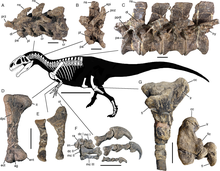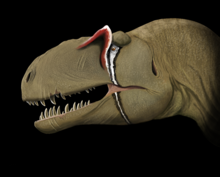| Asfaltovenator | |
|---|---|

| |
| Scientific classification | |
| Domain: | Eukaryota |
| Kingdom: | Animalia |
| Phylum: | Chordata |
| Clade: | Dinosauria |
| Clade: | Saurischia |
| Clade: | Theropoda |
| Superfamily: | †Allosauroidea |
| Genus: | †Asfaltovenator Rauhut & Pol, 2019 |
| Type species | |
| †Asfaltovenator vialidadi Rauhut & Pol, 2019
| |
Asfaltovenator (meaning "Cañadón Asfalto Formation hunter" after the fossil formation in which its fossils were found) is a genus of possibly allosauroid dinosaur from the Lower Jurassic (Middle Toarcian) Cañadón Asfalto Formation of Chubut Province, Argentina. The type and only species is Asfaltovenator vialidadi.
Discovery
[edit]
In 2002, technician Leandro Canesa discovered a theropod skeleton roughly a mile north of Cerro Condor. Excavations started in 2005, and the fossil was removed in its entirety in 2007. It was then prepared by Mariano Caffa, a process that took five years due to the extreme hardness of the stone matrix. Between 2013 and 2015, it was compared with the specimens of related theropods.[2][3]
In 2019, the type species Asfaltovenator vialidadi was named and described by Oliver Walter, Mischa Rauhut and Diego Pol. The generic name combines a reference to the Cañadón Asfalto Formation with the Latin word venator, meaning "hunter". The specific name honours the Dirección Nacional de Vialidad for assisting the Museo Paleontológico "Egidio Feruglio" in recovering the fossil.[2]
Asfaltovenator is only known from the holotype specimen MPEF PV 3440, which was found in a layer of the Cañadón Asfalto Formation which dates to the Middle Toarcian (179-178 million years old). The age was established by using zircon datation, with the location of the specimen being closer to the younger date.[4] The holotype consists of a partial skeleton with a skull, and includes the mostly complete skull and lower jaws and most of the postcranial skeleton in front of the hips, including ten cervical (neck) vertebrae, thirteen dorsal (back) vertebrae and the first sacral vertebra, the complete shoulder girdle minus the furcula, and both forelimbs. The holotype also includes the distal portion of the pubic bones as well as a partial right hindlimb consisting of the distal portion of the femur and proximal portions of the tibia and fibula, and a partial foot.[2]
Description
[edit]

Asfaltovenator was a fairly large animal similar in size to Allosaurus, with the holotype skull being 75–80 cm (2.46–2.62 ft) in length and the total body length being estimated at 7–8 m (23–26 ft).[2]
The describers identified several distinctive features, some of which are autapomorphies, some seen on the premaxillary teeth serrations and foramen (but also shared with more basal Neotheropods like Dilophosaurus, Dracovenator, and in the Coelurosaur Proceratosaurus), others on the paradental plates and palatal shelf (that are shared with Ceratosaurians & others). In the other side it has clear Allosauroid features, for example on the premaxilla ( that are also recorded in some Megalosauroids), the maxilla or the lacrimal with a supraantorbital crest.[5] The exoccipital bone of the rear skull shows distinctive horizontal ridges between the paraoccipital process and the foramen magnum. On the third and fourth neck vertebrae, the neural spines are triangular and swept backwards. The eleventh and twelfth back vertebrae possess an additional forward ridge on the underside of the diapophysis, the process for the articulation facet of the top rib head.[2]
Classification
[edit]Due to Asfaltovenator posessing both primitive and derived characters within Tetanurae, its inclusion in the phylogenetic analysis disrupted current views of tetanuran phylogeny, with the analysis recovering Asfaltovenator as a basal allosauroid between piatnitzkysaurids and metriacanthosaurids, and traditional Megalosauroidea as a paraphyletic grade leading to Allosauroidea.[2] The unique combination of characteristics seen in Asfaltovenator may also indicate that megalosauroids and allosauroids shared a common ancestor not shared with coelurosaurs, another tetanuran group.[citation needed]

In 2024, Andrea Cau suggested a different position within Megalosauroidea, as a sister taxon of Sciurumimus and/or within a larger stem group.[6] In the same year, a study by Oliver Rauhut and colleagues included Asfaltovenator within Allosauridae based on their phylogenetic analysis.[7] The ongoing osteology notified also this position, also recovering it in a clade with Allosaurus in some trees or as an early branching allosauroid of some kind. A monophyletic Carnosauria is not recovered anymore, and the other Cañadón Asfalto tetanurans aren't closely related to Asfaltovenator.[5]
Paleoecology
[edit]The holotype of Asfaltovenator comes from the Chacritas Member of the Cañadón Asfalto Formation. This member is mostly made up of two major depositional settings: lacustrine and fluvial deposits. Both of these have intervals of tuffaceous materials, suggesting the presence of volcanic activity.[8] Palustrine littoral environment levels are seen at Cerro Cóndor and Estancia Fossati, characterized by the presence of lacustrine limestones interbedded with shales, tuffs and sandstones.[9] The lacustrine section has been called the "Chacritas Paleolake", and seems to have been a rather saline or even hypersaline hydrologically closed pan lake, shallow in depth, with marginal zones and palustrine subenvironments made of low-energy ramp-like margins.[10][11]
The Toarcian Oceanic Anoxic Event (TOAE), recently been recognized as a key driver of Jurassic dinosaur evolution, linked to volcanic eruptions in the Karoo-Ferrar region that caused multiple extinction pulses. While well-studied in marine invertebrates, the event's impact on terrestrial vertebrates, particularly tetanuran theropods, is less understood. However, evidence suggests the TOAE triggered rapid diversification in these groups as seen with the presence of Asfaltovenator and others in Middle Toarcian strata.[2] This surge in morphological evolution, followed by a decline in the Middle Jurassic, aligns with patterns seen after other extinction events. Ecological release after the TOAE likely facilitated this rapid evolution, though reconstructing lineage relationships is challenging due to high homoplasy and incomplete fossil records.[2]
References
[edit]- ^ Fantasia, A.; Föllmi, K. B.; Adatte, T.; Spangenberg, J. E.; Schoene, B.; Barker, R. T.; Scasso, R. A. (2021). "Late Toarcian continental palaeoenvironmental conditions: An example from the Canadon Asfalto Formation in southern Argentina". Gondwana Research. 89 (1): 47–65. Bibcode:2021GondR..89...47F. doi:10.1016/j.gr.2020.10.001. S2CID 225120452. Retrieved 27 August 2021.
- ^ a b c d e f g h Rauhut, Oliver W. M.; Pol, Diego (2019-12-11). "Probable basal allosauroid from the early Middle Jurassic Cañadón Asfalto Formation of Argentina highlights phylogenetic uncertainty in tetanuran theropod dinosaurs". Scientific Reports. 9 (1): 18826. Bibcode:2019NatSR...918826R. doi:10.1038/s41598-019-53672-7. ISSN 2045-2322. PMC 6906444. PMID 31827108.
- ^ "Asfaltovenator Vialidadi: Hallaron en la Patagonia uno de los más antiguos y completos dinosaurios carnívoros del Jurásico". La Nación. 11 December 2019.
- ^ Pol, D.; Gomez, K.; Holwerda, F. M.; Rauhut, O. W.; Carballido, J. L. (2022). "Sauropods from the Early Jurassic of South America and the Radiation of Eusauropoda". South American Sauropodomorph Dinosaurs. 1 (1): 131–163. doi:10.1007/978-3-030-95959-3_4. Retrieved 2 May 2022.
- ^ a b Cuesta, E.; Pol, D.; Rauhut, O.W.M. (2024). "'Going around in the head' of Asfaltovenator: new data on the skull of the type specimen of the Patagonian allosauroid (Early Jurassic)" (PDF). EAVP2024 Abstract book and programme. 18 (1): 10–11.
- ^ Cau, Andrea (2024). "A Unified Framework for Predatory Dinosaur Macroevolution" (PDF). Bollettino della Società Paleontologica Italiana. 63 (1): 1–19. doi:10.4435/BSPI.2024.08. ISSN 0375-7633.
- ^ Rauhut, Oliver W M; Bakirov, Aizek A; Wings, Oliver; Fernandes, Alexandra E; Hübner, Tom R (2024-08-01). "A new theropod dinosaur from the Callovian Balabansai Formation of Kyrgyzstan". Zoological Journal of the Linnean Society. 201 (4). doi:10.1093/zoolinnean/zlae090. ISSN 0024-4082.
- ^ Cabaleri, N. G.; Benavente, C. A. (2013). "Sedimentology and paleoenvironments of the Las Chacritas carbonate paleolake, Cañadón Asfalto Formation (Jurassic), Patagonia, Argentina". Sedimentary Geology. 284 (4): 91–105. Bibcode:2013SedG..284...91C. doi:10.1016/j.sedgeo.2012.11.008. hdl:11336/182449. Retrieved 29 July 2022.
- ^ Cabaleri, Nora; Volkheimer, Wolfgang; Armella, Claudia; Gallego, Oscar Florencio; Monferran, Mateo Daniel; Cagnoni, Mariana; Silva Nieto, Diego; Páez, Manuhel (2010). "Humedales jurásicos y del J/K en la Cuenca Cañadón Asfalto, río Chubut medio. Argentina". 4º Simposio Argentino del Jurásico. 4 (2): 18.
- ^ Cabaleri, N. G.; Armella, C.; Silva Nieto, D. G. (2005). "Saline paleolake of the Cañadón Asfalto Formation (Middle-Upper Jurassic), Cerro Cóndor, Chubut province (Patagonia), Argentina". Facies. 51 (1): 350–364. Bibcode:2005Faci...51..350C. doi:10.1007/s10347-004-0042-5. S2CID 129090656. Retrieved 17 August 2022.
- ^ Cabaleri, N.; Volkheimer, W.; Armella, C.; Gallego, O.; Silva Nieto, D.; Páez, M.; Koukharsky, M. (2010). "Estratigrafía, análisis de facies y paleoambientes de la Formación Cañadón Asfalto en el depocentro jurásico Cerro Cóndor, provincia del Chubut". Revista de la Asociación Geológica Argentina. 66 (3): 349–367. Retrieved 2022-09-05.




















